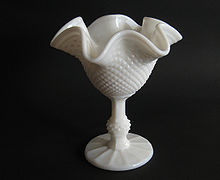Milk glass
This article needs additional citations for verification. (February 2009) |

Milk glass is an opaque or translucent, milk white or colored glass that can be blown or pressed into a wide variety of shapes. First made in Venice in the 16th century, colors include blue, pink, yellow, brown, black, and white.
Principle

Milk glass contains dispersion of particles with
The particles are produced via addition of opacifiers to the melt. Some opacifiers can be insoluble and only dispersed in the melt. Others are added as precursors and react in the melt, or dissolve in the molten glass and then precipitate as crystals on cooling; this is similar to color production in striking glasses, but the particles are much bigger.
A variety of opacifiers can be used, such as
, which can be chemically considered to be a specific kind of milk glass.History

First made in Venice in the 16th century (lattimo) as a translucent competitor for porcelain, colors include blue, pink, yellow, brown, black, and white. Some 19th-century glass makers called milky white opaque glass "opal glass". The name milk glass is relatively recent.[2] [3]
Made into decorative

Milk glass is often used for architectural decoration when one of the underlying purposes is the display of graphic information. The original milk glass marquee of the Chicago Theatre has been donated to the Smithsonian Institution.[4] A famous use of milk glass is for the four faces of the information booth clock at Grand Central Terminal in New York City. Barbetta, the New York Italian restaurant founded in 1906 and still in business as of 2022,[5] has what is said to be the last opal glass sign in the city.[6]
Collectible
Milk glass has a considerable following of collectors.[7] Glass makers continue to produce both original pieces and reproductions of popular collectible pieces and patterns.[8]
Notable U.S. manufacturers

- Dithridge & Company
- Fenton Glass Company
- Fostoria Glass Company
- Imperial Glass Company
- Kanawha Glass Co.
- L.E. Smith Glass Company[9]
- Mosser Glass
- Thai Soojung Glass Company Limited[10]
- Westmoreland Glass Company
References
- ^ "Blue & red - Causes of Color". www.webexhibits.org.
- ISBN 9780896895317.)
{{cite book}}: CS1 maint: location (link - ^ Lyon, Joshua. "The Collector's Guide To Milk Glass". Elle Decor. Hearst Digital Media. Retrieved 31 August 2022.
- ^ "1986: The Chicago Theater Reopens". Chicago Public Library. February 2006. Archived from the original on February 12, 2008. Retrieved May 7, 2007.
- ^ "Barbetta".
- ^ Besonen, Julie (2 February 2018). "The Elegant Relic of Restaurant Row". The New York Times.
- ISBN 9780517097403.
- ISBN 9780764306617.
- ISBN 978-1-60460-969-1.
- ^ Thai Soojung Glass Company Limited
